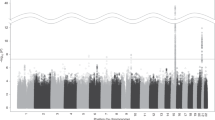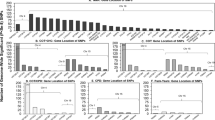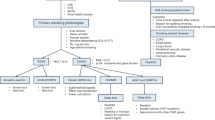Abstract
Smoking is a leading cause of preventable death, causing about 5 million premature deaths worldwide each year1,2. Evidence for genetic influence on smoking behaviour and nicotine dependence (ND)3,4,5,6,7,8 has prompted a search for susceptibility genes. Furthermore, assessing the impact of sequence variants on smoking-related diseases is important to public health9,10. Smoking is the major risk factor for lung cancer (LC)11,12,13,14 and is one of the main risk factors for peripheral arterial disease (PAD)15,16,17. Here we identify a common variant in the nicotinic acetylcholine receptor gene cluster on chromosome 15q24 with an effect on smoking quantity, ND and the risk of two smoking-related diseases in populations of European descent. The variant has an effect on the number of cigarettes smoked per day in our sample of smokers. The same variant was associated with ND in a previous genome-wide association study that used low-quantity smokers as controls18,19, and with a similar approach we observe a highly significant association with ND. A comparison of cases of LC and PAD with population controls each showed that the variant confers risk of LC and PAD. The findings provide a case study of a gene–environment interaction20, highlighting the role of nicotine addiction in the pathology of other serious diseases.
This is a preview of subscription content, access via your institution
Access options
Subscribe to this journal
Receive 51 print issues and online access
$199.00 per year
only $3.90 per issue
Buy this article
- Purchase on Springer Link
- Instant access to full article PDF
Prices may be subject to local taxes which are calculated during checkout
Similar content being viewed by others
References
Anonymous Annual smoking-attributable mortality, years of potential life lost, and productivity losses–United States, 1997–2001. MMWR Morb. Mortal. Wkly. Rep. 54, 625–628 (2005)
World Health Organization. Economics of tobacco control. 〈http://www.who.int/gb/fctc/PDF/wg1/e1t2.pdf〉
Carmelli, D., Swan, G. E., Robinette, D. & Fabsitz, R. Genetic influence on smoking—a study of male twins. N. Engl. J. Med. 327, 829–833 (1992)
Li, M. D., Cheng, R., Ma, J. Z. & Swan, G. E. A meta-analysis of estimated genetic and environmental effects on smoking behavior in male and female adult twins. Addiction 98, 23–31 (2003)
Kendler, K. S. et al. A population-based twin study in women of smoking initiation and nicotine dependence. Psychol. Med. 29, 299–308 (1999)
Heath, A. C. & Martin, N. G. Genetic models for the natural history of smoking: evidence for a genetic influence on smoking persistence. Addict. Behav. 18, 19–34 (1993)
Madden, P. A. et al. The genetics of smoking persistence in men and women: a multicultural study. Behav. Genet. 29, 423–431 (1999)
Vink, J. M., Willemsen, G., Beem, A. L. & Boomsma, D. I. The Fagerstrom Test for Nicotine Dependence in a Dutch sample of daily smokers and ex-smokers. Addict. Behav. 30, 575–579 (2005)
Carlsten, C. & Burke, W. Potential for genetics to promote public health: genetics research on smoking suggests caution about expectations. J. Am. Med. Assoc. 296, 2480–2482 (2006)
Bierut, L. J. et al. Genetic research and smoking behavior. J. Am. Med. Assoc. 297, 809 (2007)
Doll, R. & Hill, A. B. A study of the aetiology of carcinoma of the lung. BMJ 2, 1271–1286 (1952)
Doll, R. & Peto, R. Cigarette smoking and bronchial carcinoma: dose and time relationships among regular smokers and lifelong non-smokers. J. Epidemiol. Community Health 32, 303–313 (1978)
Wynder, E. L. & Graham, E. A. Tobacco smoking as a possible etiologic factor in bronchiogenic carcinoma; a study of 684 proved cases. J. Am. Med. Assoc. 143, 329–336 (1950)
Parkin, D. M., Bray, F., Ferlay, J. & Pisani, P. Global cancer statistics, 2002. CA Cancer J. Clin. 55, 74–108 (2005)
Hirsch, A. T. et al. ACC/AHA 2005 Practice Guidelines for the management of patients with peripheral arterial disease (lower extremity, renal, mesenteric, and abdominal aortic): a collaborative report from the American Association for Vascular Surgery/Society for Vascular Surgery, Society for Cardiovascular Angiography and Interventions, Society for Vascular Medicine and Biology, Society of Interventional Radiology, and the ACC/AHA Task Force on Practice Guidelines (Writing Committee to Develop Guidelines for the Management of Patients With Peripheral Arterial Disease): endorsed by the American Association of Cardiovascular and Pulmonary Rehabilitation; National Heart, Lung, and Blood Institute; Society for Vascular Nursing; TransAtlantic Inter-Society Consensus; and Vascular Disease Foundation. Circulation 113, e463–e654 (2006)
Powell, J. T. et al. Risk factors associated with the development of peripheral arterial disease in smokers: a case-control study. Atherosclerosis 129, 41–48 (1997)
Price, J. F. et al. Relationship between smoking and cardiovascular risk factors in the development of peripheral arterial disease and coronary artery disease: Edinburgh Artery Study. Eur. Heart J. 20, 344–353 (1999)
Saccone, S. F. et al. Cholinergic nicotinic receptor genes implicated in a nicotine dependence association study targeting 348 candidate genes with 3713 SNPs. Hum. Mol. Genet. 16, 36–49 (2007)
Bierut, L. J. et al. Novel genes identified in a high-density genome wide association study for nicotine dependence. Hum. Mol. Genet. 16, 24–35 (2007)
Plomin, R., DeFries, J. C. & Loehlin, J. C. Genotype–environment interaction and correlation in the analysis of human behavior. Psychol. Bull. 84, 309–322 (1977)
Berrettini, W. et al. α-5/α-3 nicotinic receptor subunit alleles increase risk for heavy smoking. Mol. Psychiatry (in the press)
Heatherton, T. F., Kozlowski, L. T., Frecker, R. C. & Fagerstrom, K. O. The Fagerstrom Test for Nicotine Dependence: a revision of the Fagerstrom Tolerance Questionnaire. Br. J. Addict. 86, 1119–1127 (1991)
Rose, J. E. Nicotine addiction and treatment. Annu. Rev. Med. 47, 493–507 (1996)
Russell, M. A. The nicotine addiction trap: a 40-year sentence for four cigarettes. Br. J. Addict. 85, 293–300 (1990)
Stolerman, I. P. & Jarvis, M. J. The scientific case that nicotine is addictive. Psychopharmacology (Berl.) 117, 2–10 (1995)
Haiman, C. A. et al. Ethnic and racial differences in the smoking-related risk of lung cancer. N. Engl. J. Med. 354, 333–342 (2006)
Stellman, S. D. et al. Lung cancer risk in white and black Americans. Ann. Epidemiol. 13, 294–302 (2003)
Peto, R. et al. Smoking, smoking cessation, and lung cancer in the UK since 1950: combination of national statistics with two case-control studies. Br. Med. J. 321, 323–329 (2000)
Devlin, B., Bacanu, S. A. & Roeder, K. Genomic control to the extreme. Nature Genet. 36, 1129–1130 (2004)
Grant, S. F. et al. Variant of transcription factor 7-like 2 (TCF7L2) gene confers risk of type 2 diabetes. Nature Genet. 38, 320–323 (2006)
Gulcher, J. R., Kristjansson, K., Gudbjartsson, H. & Stefansson, K. Protection of privacy by third-party encryption in genetic research in Iceland. Eur. J. Hum. Genet. 8, 739–742 (2000)
Thorgeirsson, T. E. et al. Anxiety with panic disorder linked to chromosome 9q in Iceland. Am. J. Hum. Genet. 72, 1221–1230 (2003)
Mueller, T. et al. Factor V Leiden, prothrombin G20210A, and methylenetetrahydrofolate reductase C677T mutations are not associated with chronic limb ischemia: the Linz Peripheral Arterial Disease (LIPAD) study. J. Vasc. Surg. 41, 808–815 (2005)
Rutherford, R. B. et al. Recommended standards for reports dealing with lower extremity ischemia: revised version. J. Vasc. Surg. 26, 517–538 (1997)
Dormandy, J. A. & Rutherford, R. B. Management of peripheral arterial disease (PAD). TASC Working Group. TransAtlantic Inter-Society Consensus (TASC). J. Vasc. Surg. 31, S1–S296 (2000)
Barani, J., Nilsson, J. A., Mattiasson, I., Lindblad, B. & Gottsater, A. Inflammatory mediators are associated with 1-year mortality in critical limb ischemia. J. Vasc. Surg. 42, 75–80 (2005)
Anonymous Suggested standards for reports dealing with lower extremity ischemia. Prepared by the Ad Hoc Committee on Reporting Standards, Society for Vascular Surgery/North American Chapter, International Society for Cardiovascular Surgery. J. Vasc. Surg. 4, 80–94 (1986)
Flex, A. et al. The -174 G/C polymorphism of the interleukin-6 gene promoter is associated with peripheral artery occlusive disease. Eur. J. Vasc. Endovasc. Surg. 24, 264–268 (2002)
Barrett, J. C. & Cardon, L. R. Evaluating coverage of genome-wide association studies. Nature Genet. 38, 659–662 (2006)
Acknowledgements
We thank the participants in the genetic studies whose contributions made this work possible, the staff at Noatun (deCODE’s recruitment centre), and personnel at deCODE’s core facilities. This work was supported in part by funds from the National Institute of Drug Abuse and the European Commission.
Author Contributions T.E.T., F.G., P.S., and T.R. contributed equally to this work. T.E.T., F.G., P.S, T.R., A.W., D.F.G., A.K. and K.S. wrote the first draft of the paper. Ha.S., H.J.I., T.G. and S.J. recruited and diagnosed the Icelandic lung cancer patients. S.E.M. recruited and diagnosed the Icelandic peripheral arterial disease patients. T.B., H.K., J.G.S., I.H, V.R., H.O., T.T. and S.J. recruited and diagnosed nicotine addiction subjects. K.K.H.A., F.d.V., P.F.A.M. and L.A.K. recruited and diagnosed the subjects from The Netherlands. D.I., M.J.V., L.A., B.S., L.M. and J.I.M. recruited and diagnosed the Spanish subjects. G.T.J. and A.M.v.R. recruited and diagnosed the subjects from New Zealand. T.M., B.P. and M.H. recruited and diagnosed subjects from Austria. A.G. and B.L. recruited and diagnosed subjects from Sweden. A.F. and R.P. recruited and diagnosed subjects from Italy. A.W., A.I., S.N.S., J.T.B., S.T., J.G., M.J., J.S., O.O. and S.N.S. performed genotyping and experimental work. L.J.G., G.B. and K.K. incorporated phenotypic data into a database and analysed it. T.E.T., F.G., P.S., T.R., A.W., K.P.M., A.M., G.T., D.F.G. and A.K. analysed the data. T.E.T., F.G., P.S., T.R., K.P.M., Hr.S., T.J., J.I.M., L.K., H.O., T.T., J.R.G., S.J., D.G., U.T., A.K. and K.S. planned, supervised and coordinated the work. All authors contributed to the final version of the paper.
Author information
Authors and Affiliations
Corresponding authors
Ethics declarations
Competing interests
Some of the authors employed by deCODE genetics own stock or stock options in the company
Supplementary information
Supplementary Information
This file contains Supplementary Methods, Supplementary Results, Supplementary Figure 1, Supplementary Tables 1-6, and additional references. (PDF 292 kb)
Rights and permissions
About this article
Cite this article
Thorgeirsson, T., Geller, F., Sulem, P. et al. A variant associated with nicotine dependence, lung cancer and peripheral arterial disease. Nature 452, 638–642 (2008). https://doi.org/10.1038/nature06846
Received:
Accepted:
Issue Date:
DOI: https://doi.org/10.1038/nature06846
This article is cited by
-
Silencing circLDLRAD3 Inhibits Lung Cancer Progression by Regulating the miR-497-5p/PFKP Axis
Molecular Biotechnology (2024)
-
Sequence variants affecting the genome-wide rate of germline microsatellite mutations
Nature Communications (2023)
-
‘Two-faces’ of hyaluronan, a dynamic barometer of disease progression in tumor microenvironment
Discover Oncology (2023)
-
Computational and experimental assessment of health risks of fine particulate matter in Nanjing and Yangzhou, China
Environmental Science and Pollution Research (2023)
-
Multi-ancestry genome-wide association study of cannabis use disorder yields insight into disease biology and public health implications
Nature Genetics (2023)
Comments
By submitting a comment you agree to abide by our Terms and Community Guidelines. If you find something abusive or that does not comply with our terms or guidelines please flag it as inappropriate.



